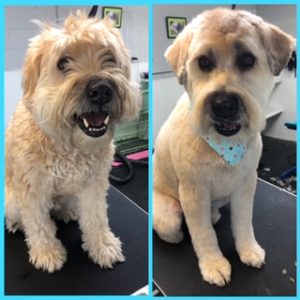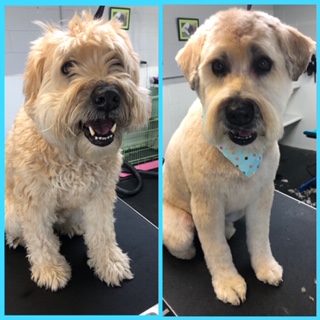 We truly appreciate dog owners who bring their puppies in at about 12 weeks of age for grooming. At this point it’s more about training them that grooming is a good thing. A basic bath, light blow dry and clip with a little nail trim goes a long way towards helping them learn to trust a groomer. In order to make sure every grooming experience feels like a spa day; your dog needs to learn to tolerate grooming when he/she is a puppy.
We truly appreciate dog owners who bring their puppies in at about 12 weeks of age for grooming. At this point it’s more about training them that grooming is a good thing. A basic bath, light blow dry and clip with a little nail trim goes a long way towards helping them learn to trust a groomer. In order to make sure every grooming experience feels like a spa day; your dog needs to learn to tolerate grooming when he/she is a puppy.
If you wait to begin grooming sessions when your dog is older, he or she may make it almost impossible to complete grooming routines, especially nail clipping and ear cleaning. Around 6 months of age your dog has developed a few fears and may not embrace this new experience as easily. Also, around this age their coat starts to change from puppy to adult. If the dog has not been properly brushed out and kept clean their coat could already be in trouble which will make the first experience more stressful than it needs to be.
Long-haired breeds are especially in need of early exposure to grooming. Their long hair requires more intense grooming sessions than short-haired breeds. By keeping them on a strict 4-6-week grooming schedule, they will learn to stand still from a young age, making it easier on them and the groomer. Hair build up and underlying mats can cause major skin problems if they are not removed. Not to mention it can cause your fur baby extreme discomfort.
Another challenge in grooming is realistic expectations, especially if a regular routine is not in place. Many people love the ‘fluffy’ look, but they don’t realize how much work goes into having a nice full coat. If the client wants fluffy but the dog has hair mats in their undercoat, we have to shave the dog and start from scratch. This look is considered ‘non fluffy’ and usually not very appealing on a longer haired breed. An example of a dog that needs daily brushing with a regular grooming routine is a doodle. Their routine should be a combination of complete service and baths to keep the coat very clean.
A good grooming routine of about every 4-6 weeks also gives the groomer a chance to check for any physical abnormalities (such as skin infections, hot spots and sores). When found early, many of these common health problems can be treated right away, before they have a chance to become more serious (and could include an expensive treatment).
In conclusion, grooming your puppy regularly is about more than just keeping him/her looking and smelling nice (although those are important benefits too!). Regular grooming is important for maintaining your puppy’s overall physical health. I hope this article encourages you to talk to us or a professional groomer about your dog’s grooming needs.
Written by Tatyana Romero, one of Paws In Time’s expert groomers.

